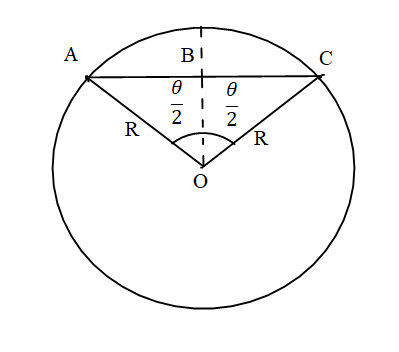
A particle moves through angular displacement
A)
B)
C)
D)
Answer
138.9k+ views
Hint: A displacement is defined as the shortest distance between the intimal and final position. The angular displacement is the displacement on the circular track which is represented by angle which is
Formula Used: The formula for the linear displacement is given by,
Complete step by step answer:
It is given in the problem that a particle moves through angular displacement
As it is given that the angle between the initial and final position or the angular displacement is given to be

Here the linear displacement is equal to AC. Let us calculate the value of AC from both of the triangle ABO and triangle BCO.
In triangle ABO,
In triangle BCO,
Since,
Replacing the values of AB and BC from the equation (1) and equation (2) in the above equation.
The linear displacement will be equal to
Note: It is advisable to the students to understand and remember the formula of the vector addition or subtraction as it can help in solving these kinds of problems. The angle
Formula Used: The formula for the linear displacement is given by,
Complete step by step answer:
It is given in the problem that a particle moves through angular displacement
As it is given that the angle between the initial and final position or the angular displacement is given to be

Here the linear displacement is equal to AC. Let us calculate the value of AC from both of the triangle ABO and triangle BCO.
In triangle ABO,
In triangle BCO,
Since,
Replacing the values of AB and BC from the equation (1) and equation (2) in the above equation.
The linear displacement will be equal to
Note: It is advisable to the students to understand and remember the formula of the vector addition or subtraction as it can help in solving these kinds of problems. The angle
Latest Vedantu courses for you
Grade 10 | MAHARASHTRABOARD | SCHOOL | English
Vedantu 10 Maharashtra Pro Lite (2025-26)
School Full course for MAHARASHTRABOARD students
₹31,500 per year
Recently Updated Pages
How to find Oxidation Number - Important Concepts for JEE

How Electromagnetic Waves are Formed - Important Concepts for JEE

Electrical Resistance - Important Concepts and Tips for JEE

Average Atomic Mass - Important Concepts and Tips for JEE

Chemical Equation - Important Concepts and Tips for JEE

Concept of CP and CV of Gas - Important Concepts and Tips for JEE

Trending doubts
JEE Main 2025 Session 2: Application Form (Out), Exam Dates (Released), Eligibility, & More

JEE Main 2025: Derivation of Equation of Trajectory in Physics

Learn About Angle Of Deviation In Prism: JEE Main Physics 2025

Electric Field Due to Uniformly Charged Ring for JEE Main 2025 - Formula and Derivation

JEE Main 2025: Conversion of Galvanometer Into Ammeter And Voltmeter in Physics

Degree of Dissociation and Its Formula With Solved Example for JEE

Other Pages
Units and Measurements Class 11 Notes: CBSE Physics Chapter 1

JEE Advanced Marks vs Ranks 2025: Understanding Category-wise Qualifying Marks and Previous Year Cut-offs

Motion in a Straight Line Class 11 Notes: CBSE Physics Chapter 2

Important Questions for CBSE Class 11 Physics Chapter 1 - Units and Measurement

NCERT Solutions for Class 11 Physics Chapter 1 Units and Measurements

NCERT Solutions for Class 11 Physics Chapter 2 Motion In A Straight Line




